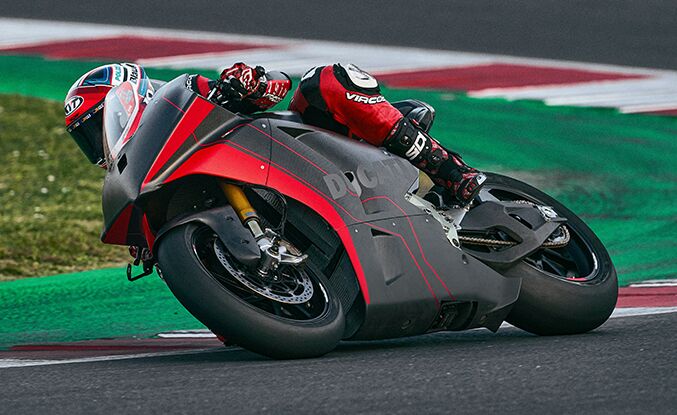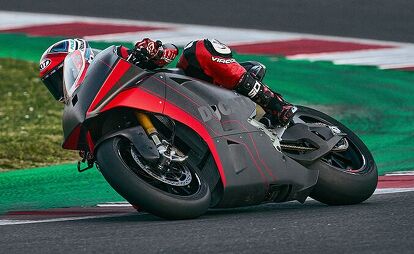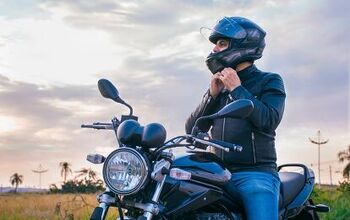Ducati MotoE Prototype Electric Racebike Makes Public Testing Debut

Ducati's MotoE racer gives hints to its production future.
Ducati today dropped a minor bombshell with the press release below, announcing testing for its prototype MotoE racer had already begun. For those unaware, Ducati is set to become the sole manufacturer for the MotoE World Cup starting in 2023, replacing Energica, whose contract as the sole – and so far only – manufacturer for MotoE expires at the end of the 2022 season.
We can see that the overall shape and design of the bike aren’t far off from the design sketches first shown back in October when Ducati made its initial MotoE announcement. To these eyes, the nose section isn’t too dissimilar to the Energica Ego Corsa race bikes being used currently.
Behind the nose, the rest of the carbon fiber and composite bodywork shows obvious influence from Ducati’s own MotoGP racer, with angular “fuel tank” shapes and a sculpted carbon fiber tail/subframe section which appears to be one integrated unit.
Details on the mechanical bits of the Ducati MotoE prototype – code-named “V21L” – like battery, motor, and controller architecture, are understandably scarce, so we’ll have to glean information from the pictures and what Ducati does tell us in its press release. Ducati admits the primary challenge of developing an electric bike, especially one meant for racing use, is managing size, weight, and battery range.
With that, we can take a guess the “21” in the code name could be a reference to the battery capacity – as in, 21kWh. Since the start of the MotoE series, Dorna has been insistent that the bikes must last the entire race distance with full power. This means running a large battery (possibly considerably larger in capacity than necessary) to ensure the show and bike performance remains exciting from the first lap to the last. When I rode the Energica Ego Corsa MotoE racer in 2019, Energica CTO Giampiero Testoni admitted the battery capacity was “over 20kWh, nominal.” The following year, Energica’s road bikes increased battery capacity to 21.5kWh. Feeling as though they don’t need to reinvent the wheel as far as battery capacity goes, it makes sense for Ducati to also use a 21kWh battery. Then again, 21 could just be a reference to the year 2021. Like we said, it’s just a guess.
The downside to a battery that large is weight, and unless Ducati has made huge strides in solid-state batteries, it stands to reason V21L could be on the wrong side of 500 pounds (or 227kg for our metric friends). However, the Volkswagen group, Ducati’s parent company, has invested heavily in the electrification of its vehicles. Maybe Ducati is borrowing some of that R&D? So, the final word on V21L’s battery tech is far from settled.
The secondary challenge plaguing race bikes – internal combustion or electric – is heat management. One way electric motorcycles manage heat is to drop performance, sometimes radically, to make it to the end. This obviously isn’t acceptable for MotoE, and indeed Ducati recognizes heat management is a major focus for its electric racer. To that end, you can see the huge radiator placed in its conventional location, presumably used to cool both the motor and the battery. Look closer and you’ll also notice the massive amounts of tape blocking most of the radiator, with only a tiny sliver still visible. This tells us the ambient temps for this first test ride were probably cool. The use of rain tires would also indicate the weather was chilly. Ducati test rider Michelle Pirro also admits the bike was operating at 70% of its performance level as to not stress its systems too much in this initial shakedown run.
Not surprisingly considering the bike’s race bike status, top-shelf suspension and brakes are used from Öhlins and Brembo, respectively. We imagine rotor size to be 330mm on both sides considering the weight of the bike. Marchesini forged wheels at both ends help to keep rotating mass to a minimum and aid in handling.
The most interesting bit (in my opinion) is at the rear of the bike. The swingarm is a very stylized piece. Usually, race bikes use much more generic shapes for swingarms, as long as it meets the stiffness parameters the manufacturer (or rider) is looking for. Something this stylized is generally reserved for production bikes. This could be a component that the future street bike – and yes, there will eventually be a street bike – could carry over.
Look closer and you’ll see the Öhlins TTX shock appears to be located in a more conventional location. This allows Ducati engineers not to compromise rear suspension geometry. The Energica Ego Corsa MotoE racer has its shock offset to the right of the swingarm, mounted directly without a linkage. This introduces several geometry and setup compromises but was necessary to accommodate the packaging of the battery and motor as close to the center of the bike as possible.
This then begs the question: How is Ducati packaging the battery and motor? We don’t exactly know, but we can see a triangular structure jutting forward from the frame’s downtube, opposite the rearsets. This appears to be a mount for the motor. Leaving us to guess the rest of the space is primarily occupied by the battery. A standard size rear sprocket suggests the motor may use a gear reduction before sending power to the back.
After that, it’s difficult to really infer much more about the Ducati MotoE prototype. It will need to be as fast, if not faster, than the current Energica Ego Corsa MotoE racers. That much is for sure. Like Energica, who created an electric racing prototype (the eCRP) first and adapted it for production, Ducati is doing the same thing. The V21L is being designed for racing first with the future production bike leaning heavily on the race bike’s tech.
We’ll publish more news as we get it, but until then you can look at the photos yourself and make your own conclusions. Ducati’s own press release is below.
Begin press release:
The Ducati MotoE bike took to the track for the first time at the Misano World Circuit Marco Simoncelli, right where the agreement with Dorna Sports was announced in October. In fact, starting from the 2023 season, the Borgo Panigale motorcycle manufacturer will be the sole supplier of motorcycles for the FIM Enel MotoE™ World Cup, the electric class of the MotoGP™ World Championship.
The electric motorcycle prototype, code-named “V21L”, is the result of the joint work of the Ducati Corse team and the Ducati R&D engineers, led by Roberto Canè, Ducati eMobility Director, and was taken out on track by Michele Pirro, professional rider and Ducati test rider since 2013, who evaluated the technical characteristics and potential of Ducati’s first electric motorcycle.
Roberto Canè, Ducati eMobility Director: “We are experiencing a truly extraordinary moment. I find it hard to believe it is reality and still not a dream! The first electric Ducati on the track is exceptional not only for its uniqueness but also for the type of undertaking: challenging both for its performance objectives and for its extremely short timescales. Precisely for this reason, the work of the whole team dedicated to the project has been incredible and today’s result repays us for the efforts made in recent months. We are certainly not finished yet; indeed, we know that the road ahead is still very long, but in the meantime, we have laid a first important ‘brick’.”
Michele Pirro, Ducati test rider: “Testing the MotoE prototype on the circuit was a great thrill, because it marks the beginning of an important chapter in Ducati history. The bike is light and already has a good balance. Furthermore, the throttle connection in the first opening phase and the ergonomics are very similar to those of a MotoGP bike. If it weren’t for the silence and for the fact that in this test, we decided to limit the power output to just 70% of performance, I could easily have imagined that I was riding my bike.”
The most important challenges in the development of an electric racing motorcycle remain related to the size, weight and range of the batteries. Ducati’s goal is to make electric motorcycles that are high-performance and characterized by their lightness available to all FIM Enel MotoE™ World Cup participants. The focus of the project are, in addition to better performance, the containment of weight and the consistency of power delivery during the race, obtained thanks to the attention in the development of a cooling system suitable for the objective.
Ducati’s experience in the FIM Enel MotoE™ World Cup will be a fundamental support for product R&D. The goal is to create, as soon as the technology allows it, a Ducati electric vehicle for road use that is sporty, light, exciting and able to satisfy all enthusiasts.
Become a Motorcycle.com insider. Get the latest motorcycle news first by subscribing to our newsletter here.

Troy's been riding motorcycles and writing about them since 2006, getting his start at Rider Magazine. From there, he moved to Sport Rider Magazine before finally landing at Motorcycle.com in 2011. A lifelong gearhead who didn't fully immerse himself in motorcycles until his teenage years, Troy's interests have always been in technology, performance, and going fast. Naturally, racing was the perfect avenue to combine all three. Troy has been racing nearly as long as he's been riding and has competed at the AMA national level. He's also won multiple club races throughout the country, culminating in a Utah Sport Bike Association championship in 2011. He has been invited as a guest instructor for the Yamaha Champions Riding School, and when he's not out riding, he's either wrenching on bikes or watching MotoGP.
More by Troy Siahaan








































Comments
Join the conversation
At least Ducati is being realistic. When asked if Ducati was going to make an electric motorcycle soon, the VP of Sales answered, "No. We think that for the kind of machine we produce now, an electric motorcycle cannot guarantee the pleasure, the range, the weight etc. that Ducati riders expect,"
This bike does have clean and beautiful lines though. I'd argue that it's better looking than all of the current Panigale range.
This is completely wrong. Energica is an outgrowth of the CRP Group, who used non-electric motorcycle racing to demonstrate their expertise in specialized 3D printing of advanced material starting in 2006. They then decided to build an e-motorcycle for this, which they started racing in 2009, under the name eCRP. In 2011 they started building a road sportbike, and in 2014 formed Energica.
p. 8-9 here:
https://www.energicamotor.c...